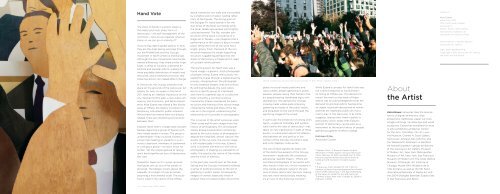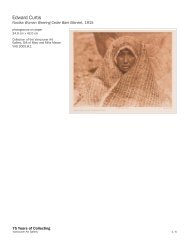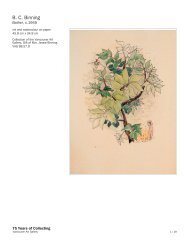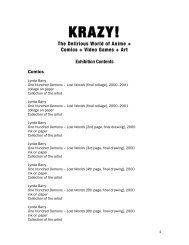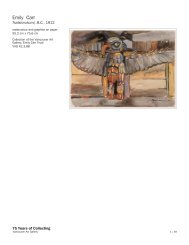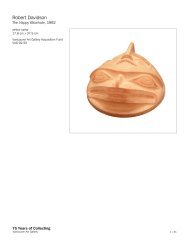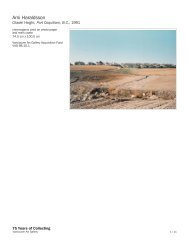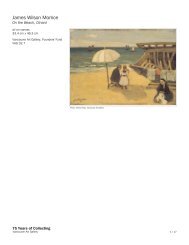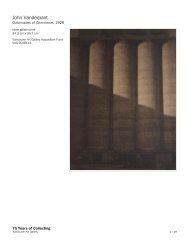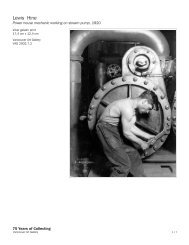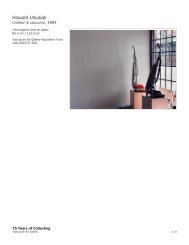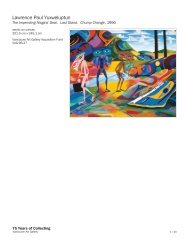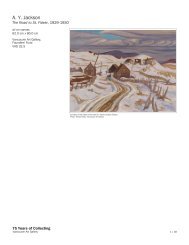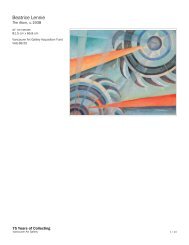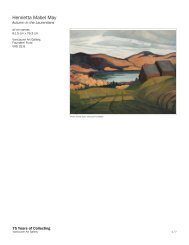here - 75 Years of Collecting - Vancouver Art Gallery
here - 75 Years of Collecting - Vancouver Art Gallery
here - 75 Years of Collecting - Vancouver Art Gallery
You also want an ePaper? Increase the reach of your titles
YUMPU automatically turns print PDFs into web optimized ePapers that Google loves.
Hand Vote<br />
The show <strong>of</strong> hands in a public space is<br />
the oldest and most direct form <strong>of</strong><br />
democracy — the self-management <strong>of</strong> the<br />
commons — how do we organize what we<br />
share, so we can go on sharing it? 1<br />
If two things define global politics in 2011,<br />
they are the Arab Spring uprisings through-<br />
out the Middle East and the Occupy<br />
movement in North America and Europe.<br />
Although the two movements have fundamental<br />
differences, they share similar impe-<br />
tuses: a sense <strong>of</strong> injustice, a demand for<br />
political and societal reform, a desire for<br />
more equitable distribution <strong>of</strong> wealth and<br />
resources, and a renewed conviction that<br />
collective action can indeed effect change.<br />
In <strong>Vancouver</strong>, the Occupy protests took<br />
place on the grounds <strong>of</strong> the <strong>Vancouver</strong> <strong>Art</strong><br />
<strong>Gallery</strong> for over six weeks in the fall <strong>of</strong><br />
2011, leaving an indelible impression on the<br />
city. Several months later, a new public artwork<br />
by San Francisco- and Berlin-based<br />
artist Kota Ezawa was raised a few blocks<br />
away at Offsite, the <strong>Gallery</strong>’s location for<br />
temporary, site-specific public artworks.<br />
While these two events were not directly<br />
related, t<strong>here</strong> are interesting connections<br />
between them.<br />
Ezawa’s Hand Vote is a large-scale wooden<br />
tableau depicting a group <strong>of</strong> figures with<br />
their hands raised in unison. The group is<br />
unidentifiable — they could be citizens in<br />
a town hall meeting or students in a university<br />
classroom, members <strong>of</strong> parliament<br />
or a religious group — we don’t know for<br />
certain. Yet the simple gesture <strong>of</strong> raising<br />
one’s hand signifies an icon <strong>of</strong> democracy:<br />
the vote.<br />
Stacked in layers as if in a pop-up book,<br />
the figures are cut out <strong>of</strong> flat panels <strong>of</strong><br />
plywood. The tableau towers above the<br />
sidewalk, at a height <strong>of</strong> over 6 metres,<br />
assuming a monumental scale. The sculpture<br />
is sited in the centre <strong>of</strong> the Offsite<br />
LEFT: Hand Vote, 2012 (detail)<br />
space, framed by two walls and surrounded<br />
by a shallow pool <strong>of</strong> water, casting reflections<br />
<strong>of</strong> the figures. The strong grain <strong>of</strong><br />
the Douglas Fir wood stands in for the<br />
skin tones <strong>of</strong> the faces and hands while<br />
the other details are painted with brightly<br />
coloured enamel. The flat, wooden construction<br />
<strong>of</strong> the piece is evocative <strong>of</strong> a<br />
stage set or façade — one imagines that a<br />
performance or film shoot is about to take<br />
place. While the front <strong>of</strong> the work has a<br />
bright, glossy finish, the back <strong>of</strong> the construction<br />
exposes the rough supporting<br />
structure, suggesting perhaps that the<br />
status <strong>of</strong> democracy is fragile and in need<br />
<strong>of</strong> constant reinforcement.<br />
The starting point for Hand Vote was a<br />
found image — a generic, stock photograph<br />
<strong>of</strong> people voting. Ezawa meticulously recreated<br />
the image through a digital drawing<br />
process, stripping down the photograph<br />
to only essential shapes, lines and colours.<br />
By eliminating details, the work refers<br />
less to a specific group <strong>of</strong> individuals<br />
and more to a general sign <strong>of</strong> a collective<br />
body united by a common purpose.<br />
Importantly, Ezawa maintained the basic<br />
structure and framing <strong>of</strong> the source image,<br />
cropping the hands and faces <strong>of</strong> the figures<br />
as in the original, underscoring the<br />
relationship <strong>of</strong> his process to photography.<br />
This is typical <strong>of</strong> the artist’s previous work.<br />
Often using well-known images from the<br />
history <strong>of</strong> photography, film and popular<br />
media, Ezawa’s pared-down renderings<br />
speak to the iconic status <strong>of</strong> photography —<br />
despite the simplified, almost cartoon-like<br />
quality <strong>of</strong> the cut-outs, the source image<br />
is still recognizable. In this way, Ezawa’s<br />
work is a potent comment on the role <strong>of</strong><br />
photography in shaping our perception <strong>of</strong><br />
reality, the spectacular nature <strong>of</strong> the media,<br />
and the limits <strong>of</strong> memory.<br />
In the past year, events such as the Arab<br />
Spring and the Occupy movement restored<br />
a sense <strong>of</strong> political purpose to the act <strong>of</strong><br />
gathering in public space. Consequently<br />
images <strong>of</strong> crowds, especially those in<br />
protest, have circulated widely around the<br />
ABOVE: Consensus, Occupy <strong>Vancouver</strong>, October 15, 2011. Photo: Stephen Collis<br />
globe via social media platforms and<br />
news outlets: people gathering in public<br />
squares, people raising their hands in the<br />
air, people bearing handmade signs with<br />
declarations. The demand for change<br />
is being made visible quite simply by<br />
gathering en masse in the public realm,<br />
and broadcast to the world through the<br />
signifying image <strong>of</strong> the crowd.<br />
In particular, the simple act <strong>of</strong> raising one’s<br />
hand — a gesture intimately and symbolically<br />
tied to the idea <strong>of</strong> democracy — has<br />
taken on new significance in light <strong>of</strong> these<br />
events. In a discussion about the relationship<br />
between art and politics in the<br />
context <strong>of</strong> the Occupy movement, poet<br />
and critic Stephen Collis writes:<br />
The use <strong>of</strong> hand signals has been one<br />
<strong>of</strong> the distinctive aspects <strong>of</strong> the Occupy<br />
movement — especially the consensusexpressing<br />
“sparkle fingers.” (T<strong>here</strong> are<br />
countless photographs <strong>of</strong> occupiers with<br />
their hands in their air.) At this moment in<br />
time, hands publically raised in the process<br />
<strong>of</strong> direct democratic decision making<br />
has new, more revolutionary meaning.<br />
It’s an icon <strong>of</strong> this historical moment. 2<br />
While Ezawa’s concept for Hand Vote was<br />
not a direct response to world events 3 ,<br />
its timing at Offsite was. The decision to<br />
mount the work on the heels <strong>of</strong> these<br />
events was an acknowledgement that the<br />
demand for political reform has become<br />
an urgent issue both abroad and at home—<br />
and that art, especially public art, has a<br />
role to play in this discourse. If, as Collis<br />
suggests, raising one’s hand in public is<br />
particularly iconic today, then Ezawa’s<br />
portrait <strong>of</strong> democracy can be seen as a<br />
monument to the recent history <strong>of</strong> people<br />
gathering together to effect change.<br />
Kathleen Ritter,<br />
Associate Curator<br />
1 Stephen Collis, “A Show <strong>of</strong> Hands: <strong>Art</strong> and<br />
Revolution in Public Space,” Occupy <strong>Vancouver</strong><br />
Voice, February 10, 2012, accessed April 5, 2012,<br />
http://occupyvancouvervoice.com/a-show-<strong>of</strong>hands-art-and-revolution-in-public-space/<br />
2 Ibid.<br />
3 A previous, much smaller (51 x 61 x 38 cm),<br />
iteration <strong>of</strong> Hand Vote was produced for the exhibition<br />
OURS: Democracy in the Age <strong>of</strong> Branding<br />
at the Vera List Center for <strong>Art</strong> and Politics at<br />
The New School, New York, October 16, 2008 to<br />
February 1, 2009.<br />
About<br />
the <strong>Art</strong>ist<br />
Kota Ezawa’s artworks take the diverse<br />
forms <strong>of</strong> digital animations, slide<br />
projections, lightboxes, paper cut-outs,<br />
intaglio etchings, ink drawings and wood<br />
sculptures. Ezawa has exhibited his work<br />
in solo exhibitions at Wexner Center<br />
for the <strong>Art</strong>s, Columbus, OH; St. Louis<br />
<strong>Art</strong> Museum; Charles H. Scott <strong>Gallery</strong>,<br />
<strong>Vancouver</strong>; <strong>Art</strong>pace, San Antonio; and<br />
the Wadsworth Atheneum in Hartford.<br />
He has participated in group exhibitions<br />
at the <strong>Vancouver</strong> <strong>Art</strong> <strong>Gallery</strong>; Museum<br />
<strong>of</strong> Modern <strong>Art</strong>, New York; Metropolitan<br />
Museum <strong>of</strong> <strong>Art</strong>, New York; San Francisco<br />
Museum <strong>of</strong> Modern <strong>Art</strong>; The Andy Warhol<br />
Museum, Pittsburgh; <strong>Art</strong> Institute <strong>of</strong><br />
Chicago; Musée d’<strong>Art</strong> Moderne de la<br />
Ville de Paris; as well as the 5th Seoul<br />
International Biennale <strong>of</strong> Media <strong>Art</strong> and<br />
the 2004 Shanghai Biennale. Ezawa lives<br />
in San Francisco and Berlin.<br />
CREDITS:<br />
Kota Ezawa<br />
Hand Vote, 2012<br />
(front and inside images)<br />
wood, paint<br />
6.053 x 9.144 x 3.201 metres<br />
site-specific installation at<br />
<strong>Vancouver</strong> <strong>Art</strong> <strong>Gallery</strong> Offsite<br />
PHOTOGRAPHY: Rachel Topham,<br />
<strong>Vancouver</strong> <strong>Art</strong> <strong>Gallery</strong><br />
ISBN: 978-1-895442-94-6<br />
Copyright © 2012 <strong>Vancouver</strong> <strong>Art</strong> <strong>Gallery</strong>,<br />
the artist and the author


